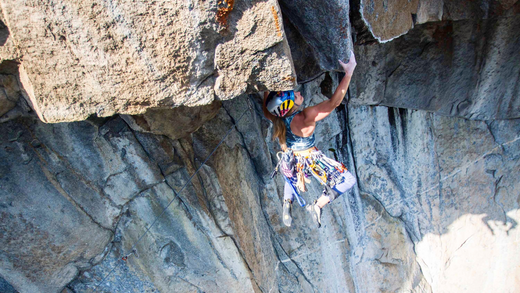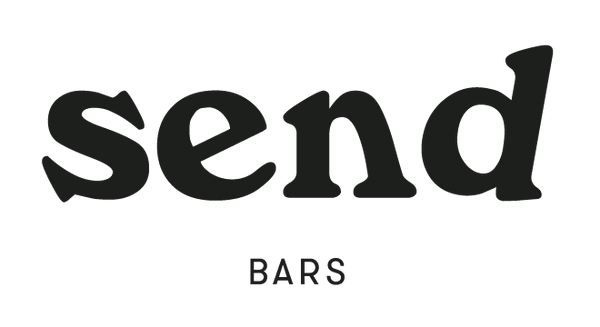Sasha DiGiulian's Recovery Routines and Recommendations

At Send, we’re all about moving with purpose, passion, and power. But let’s be real: the road to peak performance isn’t always smooth. Every climb, workout, and tumble takes its toll on our bodies. That’s why recovery isn’t just a luxury—it’s a non-negotiable. This week we sat down with Sasha DiGiulian for an inside look at her recovery routine as a professional athlete. No matter how you send it, you can't miss these insights!
As someone who pushes the limits in climbing, how important is it to have a reliable recovery routine? How do you balance the need for recovery with the desire to keep pushing your limits?
"As a professional rock climber, having a reliable recovery routine is absolutely essential. Climbing pushes your body and mind to their limits, and recovery is what allows you to show up at your best day after day. It’s not just about healing; it’s about giving your body the tools it needs to adapt, grow stronger, and prevent injury.
For me, recovery is non-negotiable. I integrate tools like Wave Therapy into my routine to address muscle tension, improve circulation, and support my overall performance. It’s about being proactive rather than reactive—if I wait until I’m burnt out or injured, I’m already steps behind.
Balancing recovery with the desire to keep pushing is tricky but crucial. I’ve learned to listen to my body and respect its limits, even when my mind wants to keep going. Recovery days and lighter sessions are just as important as peak training. It’s about the long game—staying healthy and climbing strong not just for one season, but for years to come. Recovery isn’t taking a step back; it’s setting yourself up to move forward even stronger."
Can you walk us through a typical day in your training regimen? Are there any specific resources or techniques you rely on to keep your body in top condition?
"Absolutely! A typical day in my training regimen is a balance between climbing-specific work, cross-training, and recovery. I usually start my mornings with a dynamic warm-up to activate my muscles and prevent injuries—this could include mobility drills, resistance bands, or light cardio. Then it’s onto climbing-specific training, whether that’s outdoor climbing on projects or indoor sessions focusing on technique, strength, or endurance.
Afternoons might involve strength training or core work, depending on where I am in my season. Functional fitness is a big part of what keeps me balanced and strong for the demands of climbing. Recovery always has a place in my day—I make time for stretching, foam rolling, and Wave Tools Therapy to address any tightness or soreness. Their tools help me stay ahead of potential issues and feel more in tune with my body.
I also work closely with my PT, Laura, who is incredible at identifying small imbalances or areas to improve. She’s a big reason I’m able to keep pushing myself without breaking down. Her guidance ensures I’m not only rehabbing effectively but also prehabbing—strengthening my body to prevent injuries before they happen.
As CEO of Send Bars, my days are often a mix of training and running the business, but I see a lot of overlap between the two. Whether it’s fueling with the right nutrition through our bars or advocating for recovery tools like Wave Tools Therapy, I’m passionate about sharing what works for me with the climbing community. Staying in top condition is a daily commitment, and it’s the small, consistent efforts that truly make a difference."

You've been a professional athlete for more than a decade now. How has your approach to body maintenance evolved over the years?
"My approach to body maintenance has evolved tremendously over the years, and a lot of it comes down to learning about my body, listening to it, and finding the right balance between going hard and giving myself the rest I need. When I was younger, I could push through almost anything—I’d train hard, climb hard, and sometimes neglect the recovery piece. But over time, I’ve realized that recovery isn’t a weakness; it’s an essential part of staying strong, resilient, and able to perform at the highest level.
One of the biggest turning points for me was my hip surgery. It was a humbling experience that taught me the importance of listening to my body and addressing issues early on. The recovery process required patience, dedication, and a deep focus on rebuilding strength and mobility. It also reinforced how crucial it is to have a strong team around me—my PT, Laura, was instrumental in guiding me back to full strength, and I’ve carried those lessons forward in how I care for my body today.
Now, I place a huge emphasis on proactive care. I use tools like Wave Tools Therapy to stay ahead of aches and pains, ensuring my muscles recover faster and my body stays in balance. Nutrition is another critical piece—I’ve learned how to fuel my body with the right nutrients to support both performance and recovery. Sleep has also become non-negotiable; it’s where the body does so much of its repair work.
After more than two decades as a professional athlete, I know now that longevity in this sport—and life in general—requires a holistic approach. Training hard is important, but so is resting hard, eating well, and giving your body the tools it needs to thrive. It’s a process of constant learning, but one I’m grateful for every day."
After your hip PAO procedure, how did you approach your recovery? Were there any surprising discoveries you made about the rehabilitation process or tools that were particularly helpful?
"Recovering from my hip PAO procedure was one of the most challenging and eye-opening experiences of my life. It wasn’t just about getting back to climbing—it was about rebuilding my foundation from the ground up. I approached my recovery with the same determination I bring to my climbing projects, but it required a completely different kind of patience and focus.
Laura was absolutely key in guiding me through the rehabilitation process. Early on, we worked on restoring basic mobility and strength, but what surprised me most was how important small, consistent actions were in driving progress. One tool that made a huge difference was the Wave Tool and their cupping therapy. The Wave Tool helped me break down scar tissue and improve circulation around the surgical site, which was crucial for healing. I also found the cups incredibly effective for releasing tight areas and increasing mobility in my hip and surrounding muscles. These tools allowed me to not only regain range of motion but also address compensations my body had developed to protect the injured area.
What I discovered through this process is how interconnected the body is. You can’t just focus on the site of injury—you have to think holistically. Recovery isn’t just about the physical aspects, either; it’s also about mental resilience. There were tough days, but the small wins—whether it was moving a little more freely or hitting a new milestone in my strength training—kept me motivated.
The experience reinforced how important it is to have the right tools and a knowledgeable team by your side. Wave Tools Therapy became an integral part of my routine, and it’s something I continue to rely on to stay mobile and injury-free. The whole process taught me that recovery isn’t just about bouncing back—it’s about coming back even stronger, with a deeper understanding of your body and what it needs to thrive."
For athletes who are just starting to take their training and recovery seriously, what would be your top three recommendations?
"My top three recommendations for athletes just starting to take their training and recovery seriously would be:
1. Listen to Your Body: This might sound simple, but it’s one of the most powerful things you can do as an athlete. Every body is unique, and learning to recognize the signals yours is sending—whether it’s fatigue, soreness, or feeling great—will guide you toward smarter training decisions. Recovery isn’t about being lazy; it’s about respecting the process your body needs to adapt and grow stronger. Prioritize rest as much as you prioritize your hardest training days.
2. Invest in Recovery Tools and Build a Routine: Having the right tools, like Wave Tools Therapy’s instruments, can be a game changer. Tools like the Wave Tool and cupping therapy have been essential for me in improving circulation, reducing muscle tension, and staying ahead of potential injuries. Make recovery part of your daily routine, even if it’s just 10-15 minutes. Small, consistent actions add up over time and keep you moving toward your goals.
3. Fuel and Rest Like a Pro: Your body can’t perform or recover without the proper fuel and rest. Nourish yourself with a diet that supports your activity level and recovery needs. And don’t underestimate the power of sleep—it’s where your body repairs itself and consolidates all the hard work you’ve put in. Treat sleep as a cornerstone of your recovery, not an afterthought.
Above all, remember that progress is a journey, not a race. It’s easy to feel like you need to push constantly, but the strongest athletes are the ones who embrace balance. When you take care of your body and mind, you’re setting yourself up to perform not just in the short term, but for the long haul. It’s about showing up as your best self, every day, and finding joy in the process."
If you’re curious about incorporating Wave Tools Therapy into your own routine, you can explore their products here. To dive deeper into Sasha’s inspiring recovery journey, don’t miss Here to Climb on HBO.

